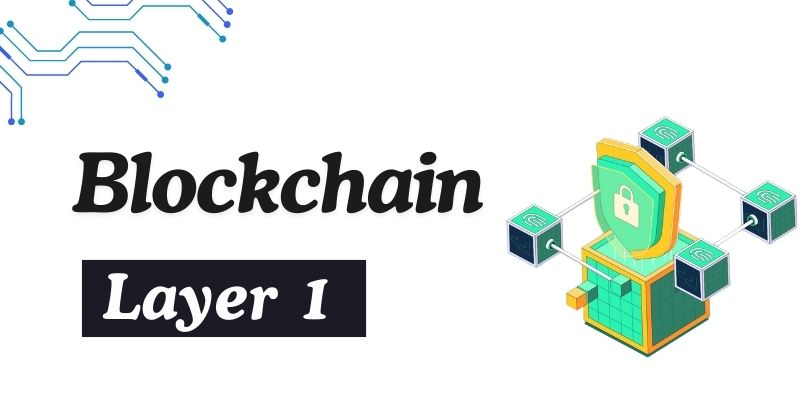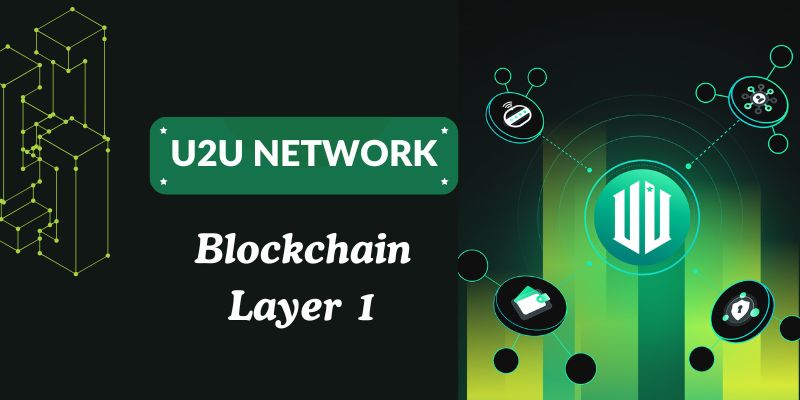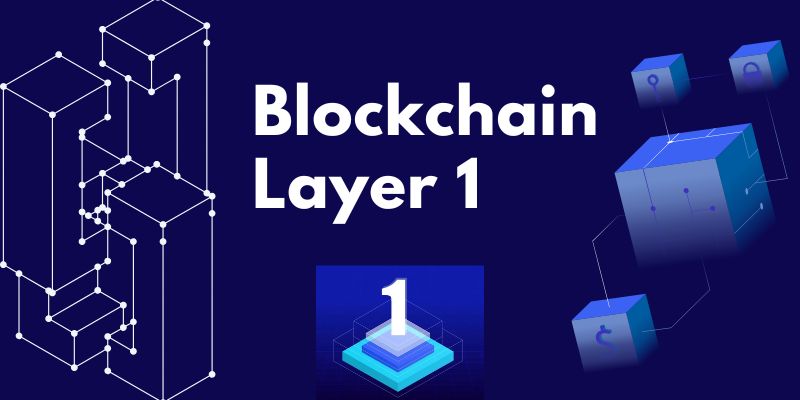Top Blockchain Layer 1 Potential Projects in 2025: Trends and Opportunities
Explore Blockchain Layer 1 potential projects like Ethereum 2.0, Solana, Avalanche, Aptos, Sui, and U2U. Learn about trends, evaluation criteria, and investment opportunities in the blockchain ecosystem.
Contents
What is Blockchain Layer 1?
Blockchain Layer 1 refers to the foundational layer or base infrastructure of a blockchain ecosystem. It encompasses the primary network, protocols, and consensus mechanisms that allow the blockchain to function as an independent and decentralized ledger. Unlike Layer 2 solutions, which operate on top of an existing blockchain to improve scalability and performance, Layer 1 is the core architecture upon which all operations and transactions are processed.

Key characteristics of Blockchain Layer 1 include:
- Decentralization: Layer 1 networks rely on decentralized nodes to validate and process transactions, ensuring trustless operations without the need for a central authority.
- Consensus Mechanisms: Popular Layer 1 blockchains use mechanisms like Proof of Work (PoW), Proof of Stake (PoS), or more innovative protocols to achieve consensus across the network.
- Native Token: Layer 1 blockchains typically have their native cryptocurrency, used for transaction fees, staking, and incentivizing network participants.
- Self-Sufficiency: Unlike Layer 2 solutions, Layer 1 blockchains do not depend on other networks for their functionality.
Examples of popular Blockchain Layer 1 platforms include Bitcoin, Ethereum, Solana, Avalanche, and Sui. These platforms form the backbone of the blockchain ecosystem, powering decentralized applications (DApps), smart contracts, and token economies.
Criteria for Evaluating the Potential of a Blockchain Layer 1
When assessing the potential of a Blockchain Layer 1 project, it’s essential to consider a blend of technical, economic, and community-related factors that collectively determine the project’s viability and future growth prospects. Here’s a comprehensive look at the key criteria to evaluate:
Scalability and Transaction Speed
A fundamental aspect of a Layer 1 blockchain’s potential is its scalability—specifically, its ability to process a large number of transactions per second (TPS). This is crucial for adoption in scenarios requiring high throughput, such as payments and decentralized applications. Projects like Solana and Avalanche have demonstrated high scalability through innovative consensus mechanisms, setting a benchmark for what’s achievable.
Security and Decentralization
Security is paramount in blockchain technology as it directly impacts user trust and asset safety. A robust Layer 1 must effectively protect against both external attacks and internal vulnerabilities. Moreover, decentralization is a core philosophy of blockchain technology, ensuring that no single entity has control over the entire network, thereby enhancing its integrity and resistance to censorship or manipulation.
Transaction Costs
The cost of transactions on the network plays a critical role in user adoption. For applications like DeFi and NFT trading, where numerous transactions can be initiated, high costs can be a deterrent. Projects that manage to minimize fees without compromising on network security and functionality tend to be more attractive for widespread use.
Developer Support and Ecosystem Growth
The strength and activity of a blockchain’s development community can be a significant indicator of its potential. A thriving ecosystem with robust development tools, comprehensive SDKs, and active participation from developers suggests a healthy and evolving blockchain platform. This is evident in ecosystems like Ethereum and Polkadot, which continuously attract innovative projects and development activities.
Interoperability
In today’s increasingly interconnected blockchain landscape, the ability of a Layer 1 project to seamlessly integrate and interact with other networks is invaluable. Interoperability extends a blockchain’s utility and opens up a myriad of possibilities for cross-chain collaboration and asset transfer, enhancing the overall value proposition of the network.
Community and Governance
The engagement level and participation of the community are crucial for the sustainable growth of a blockchain project. A vibrant community not only helps in spreading awareness and adoption but also plays a key role in governance. Projects with decentralized governance models allow community members to have a say in key decisions, aligning with the decentralized ethos of blockchain technology.
By thoroughly assessing these criteria, stakeholders can gauge the robustness, adaptability, and growth trajectory of Layer 1 blockchain projects. Such an evaluation helps in identifying platforms that not only promise technological innovation but also show potential for widespread adoption and long-term success in the ever-evolving blockchain ecosystem.
Top Potential Blockchain Layer 1 Projects
With numerous Blockchain Layer 1 platforms emerging, a few stand out due to their innovative approaches, technical capabilities, and active ecosystems. Below are some of the most promising Layer 1 projects:
Ethereum 2.0
Overview: An upgrade of the original Ethereum blockchain, Ethereum 2.0 transitions from Proof of Work (PoW) to Proof of Stake (PoS) to enhance scalability, security, and sustainability.
Key Features:
- Shard chains to improve transaction throughput.
- Reduced energy consumption with PoS.
Potential: Ethereum remains a leader in decentralized applications (DApps) and DeFi, attracting developers and investors worldwide.
Solana
Overview: Known for its lightning-fast transaction speeds and low fees, Solana leverages a unique Proof of History (PoH) mechanism combined with Proof of Stake.
Key Features:
- High throughput, processing over 65,000 TPS.
- Ideal for NFT marketplaces and gaming DApps.
Potential: Solana is highly scalable and continuously expanding its ecosystem.
Avalanche
Overview: A highly flexible platform that allows developers to create customized blockchain subnets (subchains) tailored to specific applications.
Key Features:
- Avalanche consensus protocol ensures quick finality.
- Subnet architecture supports application-specific blockchains.
Potential: Avalanche’s modularity makes it suitable for enterprise-grade solutions and DeFi applications.
Aptos
Overview: A next-generation Layer 1 blockchain developed by former Meta engineers, focusing on speed, scalability, and security.
Key Features:
- Uses the Move programming language for safer smart contracts.
- Designed for high transaction throughput and efficiency.
Potential: Backed by significant venture funding, Aptos is positioned as a competitive platform for new developers.
Sui
Overview: Another blockchain born from Meta’s Diem project, Sui emphasizes low latency and high throughput for decentralized finance (DeFi) and NFT use cases.
Key Features:
- Optimized parallel transaction processing.
- Focused on user-friendly application development.
Potential: Sui is rapidly gaining attention due to its innovative technology and developer-friendly ecosystem.
U2U
Overview: U2U is an emerging Blockchain Layer 1 project focused on creating a highly interoperable and user-centric platform. It aims to simplify blockchain integration for developers while offering an exceptional user experience for end-users.

Key Features:
- High scalability with a unique consensus mechanism designed for efficiency and speed.
- Interoperability-focused architecture to connect seamlessly with other Layer 1 and Layer 2 blockchains.
- Developer-friendly tools for faster DApp development.
Potential: U2U stands out with its emphasis on user-to-user (U2U) interactions and its growing ecosystem, making it a promising contender in the Layer 1 space.
Strengths and Weaknesses of Blockchain Layer 1 Projects
The landscape of Blockchain Layer 1 projects is diverse, with each platform presenting unique advantages and facing distinct challenges. Below is a detailed analysis of the strengths and weaknesses of some of the top contenders in this space, including emerging projects like U2U:
Ethereum 2.0
- Strengths
Robust Ecosystem: Ethereum boasts a massive developer community and an extensive array of decentralized applications (DApps) and smart contracts, making it a leading platform in terms of ecosystem maturity.
Enhanced Security and Decentralization: With its transition to Proof of Stake (PoS), Ethereum 2.0 aims to maintain high security and decentralization, aligning with core blockchain principles.
- Weaknesses
Complex Transition: The shift to Ethereum 2.0 involves significant upgrades, which have been gradual and complex, posing challenges in migration and adoption.
Scalability Issues: Despite improvements, Ethereum faces stiff competition from newer platforms that offer greater scalability out of the box.
Solana
- Strengths
High Transaction Speed: Known for its lightning-fast transaction speeds, Solana is optimal for applications requiring quick finality, such as microtransactions and high-volume NFT marketplaces.
Cost Efficiency: Extremely low transaction fees enhance its appeal for developers and end-users alike.
- Weaknesses
Network Stability: Solana has experienced several high-profile network outages, raising concerns about its reliability and robustness.
Decentralization Concerns: Its model and architecture offer less decentralization compared to more traditional blockchains like Ethereum.
Avalanche
- Strengths
Subnet Architecture: Allows for customization and flexibility in creating specific use-case blockchains, enhancing its applicability across various industries.
Quick Finality: Its consensus mechanism provides rapid transaction confirmation, improving user experience.
- Weaknesses
Smaller Developer Base: Although growing, Avalanche’s ecosystem and developer community are smaller than Ethereum’s.
Limited Broader Adoption: Primarily known within DeFi circles, Avalanche is still expanding its reach to other domains.
Aptos
- Strengths
Innovative Programming Environment: Utilizes the Move programming language, designed to ensure safe and scalable smart contract execution.
Scalability Focus: Built to handle large volumes of transactions efficiently, targeting mainstream adoption.
- Weaknesses
Nascent Ecosystem: As a relatively new player, Aptos needs time to develop a robust ecosystem and gain wider community traction.
Performance Provenance: Must prove its capabilities under varied and sustained real-world use cases.
Sui
- Strengths
Parallel Processing Capabilities: Designed for high scalability through parallel transaction processing, making it highly efficient for DeFi and NFTs.
Emerging Technologies: Incorporates cutting-edge approaches to scalability and transaction throughput.
- Weaknesses
Intense Competition: Competes with established and other emerging Layer 1s, needing to distinctly prove its value proposition.
Ecosystem Development: Still in the stages of building its community and developer support base.
U2U
- Strengths
Interoperability Focus: Emphasizes seamless integration with other blockchain networks, enhancing its utility as a connector within the blockchain ecosystem.
User-Centric Design: Prioritizes accessibility and ease of use, appealing to a broad audience with its intuitive interface and low fees.
- Weaknesses
Market Establishment: As a new entrant, U2U faces the challenge of building credibility and a solid track record in the blockchain community.
Adoption Curve: Needs to demonstrate its capability to handle widespread adoption and large-scale operational demands effectively.
Each of these Layer 1 projects contributes uniquely to the evolving blockchain ecosystem, with their respective strengths and weaknesses shaping their paths forward. For stakeholders considering investments or development on these platforms, understanding these dynamics is crucial for making informed decisions.
Trends and Investment Opportunities in Blockchain Layer 1
The Blockchain Layer 1 sector is experiencing rapid evolution, driven by technological advancements and increased global adoption. Here’s an analysis of current trends and corresponding investment opportunities that are shaping this dynamic field:

Transition to Energy-Efficient Consensus Mechanisms
Trend: A significant shift is occurring from the energy-intensive Proof of Work (PoW) to more sustainable Proof of Stake (PoS) mechanisms, exemplified by the major upgrade in Ethereum 2.0. This trend reflects a broader industry movement towards reducing the environmental impact of blockchain operations.
Opportunity: Investments in platforms that embrace eco-friendly consensus mechanisms are not only environmentally responsible but also increasingly demanded by both users and regulators. This shift represents a growing market segment keen on sustainability, providing lucrative opportunities for forward-thinking investors.
Interoperability Across Blockchains
Trend: The need for interoperability is more acute than ever as the blockchain ecosystem becomes more fragmented. Platforms that facilitate seamless cross-chain communication, such as U2U, are at the forefront of this trend, breaking down barriers between different networks.
Opportunity: There is significant potential for growth in investments in interoperable Layer 1 solutions. These platforms are likely to become backbone technologies in a future where multi-chain operations are standard, making them critical players in the blockchain space.
Focus on Developer-Friendly Environments
Trend: There is an increasing emphasis on making blockchain platforms more accessible to developers through enhanced tools and languages, such as the Move programming language used by Aptos and the comprehensive SDKs provided by U2U.
Opportunity: Investing in platforms that prioritize developer engagement can lead to early access to new applications and innovations. These ecosystems often see rapid growth and high adoption rates, which can translate into substantial returns.
Growing Adoption of Decentralized Finance (DeFi) and NFTs
Trend: The markets for DeFi and NFTs are expanding rapidly, driving demand for robust, scalable, and secure Layer 1 platforms, with Solana and Sui being notable examples.
Opportunity: Layer 1 blockchains that are optimized for DeFi and NFT functionalities are well-positioned to capitalize on these sectors’ explosive growth. Investments in these platforms can tap into the burgeoning market spaces that show no signs of slowing down.
Increasing Institutional Interest
Trend: More institutions are exploring blockchain for enterprise solutions and financial systems, attracted by the promise of enhanced security and efficiency.
Opportunity: Platforms like Avalanche that offer tailored solutions for enterprises, such as subnets for customized applications, present high-value investment opportunities. These projects cater to a growing need for blockchain integration in traditional sectors, potentially offering high returns as adoption escalates.
Rise of New Entrants
Trend: Innovative new platforms like U2U are emerging to address longstanding challenges in the blockchain space, including scalability, security, and user experience.
Opportunity: Early investments in these pioneering projects can be particularly advantageous. As these platforms evolve and potentially disrupt the market, initial investors stand to gain from their upward trajectory and integration into broader blockchain ecosystems.
These trends indicate a robust and dynamic future for Blockchain Layer 1 technologies, presenting diverse opportunities for investors looking to engage with the cutting edge of blockchain innovation.
Blockchain Layer 1 platforms are the backbone of the decentralized ecosystem, driving innovations across DeFi, NFTs, and other sectors. As the space continues to evolve, identifying and investing in potential Layer 1 projects is essential for staying ahead in the blockchain revolution.